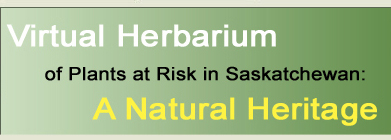
|

|

|

|

|

|

|
|
|
|
|
|
| Woodsia oregana ssp. oregana D.C. Eat. | Species Image Gallery (opens in a new window) |
||||||||||||||||||||||||||||||||
| TAXONOMY | |||||||||||||||||||||||||||||||||
| Family: | Dryopteridaceae | ||||||||||||||||||||||||||||||||
| Genus: | Woodsia | ||||||||||||||||||||||||||||||||
| Species Synonyms: | none | ||||||||||||||||||||||||||||||||
| Common Names: | Oregon cliff-fern Oregon woodsia cliff-fern |
||||||||||||||||||||||||||||||||
| DISTRIBUTION | |||||||||||||||||||||||||||||||||
| Canada: | British Columbia – southern Mackenzie District – northwestern and southwestern Saskatchewan – southwestern Ontario – southern Quebec | ||||||||||||||||||||||||||||||||
| Saskatchewan: | northwestern and southwestern Saskatchewan; Lake Athabasca, Cypress Hills | ||||||||||||||||||||||||||||||||
| Ecoregion: | Cypress Upland, Mid-Boreal Lowland, Tazin Lake Upland | ||||||||||||||||||||||||||||||||
| HABITAT | |||||||||||||||||||||||||||||||||
| Saskatchewan: | granitic or calcareous cliffs, outcrops, and rocky slopes | ||||||||||||||||||||||||||||||||
| Associated species: | Antennaria umbrinella, Arenaria congesta, Saxifraga rhomboidea | ||||||||||||||||||||||||||||||||
| RARITY STATUS | |||||||||||||||||||||||||||||||||
| Provincial
Status According to Harms (2003): |
Vulnerable |
||||||||||||||||||||||||||||||||
| Nature Conservancy Status: | G5T5 S2 |
||||||||||||||||||||||||||||||||
| Saskatchewan
Species at Risk Status: |
None |
||||||||||||||||||||||||||||||||
| COSEWIC Status: | None |
||||||||||||||||||||||||||||||||
| Woodsia oregana ssp. oregana is vulnerable in Saskatchewan because it is rare or uncommon. This species is wide-ranging, but most local populations are small. No immediate threats are known, but are possible in the future. | |||||||||||||||||||||||||||||||||
| SPECIES DESCRIPTION | |||||||||||||||||||||||||||||||||
| Roots: | compact, erect to ascending, to 5 cm long, few to many persistent petiole bases of unequal lengths; scales few, narrowly lanceolate, often uniformly brown, at least some with dark central stripe and pale brown margins | ||||||||||||||||||||||||||||||||
| Fronds: | 4 – 25 cm long, 1 – 5 cm wide | ||||||||||||||||||||||||||||||||
| Stipes: | not articulate above base, somewhat pliable and resistant to shattering, reddish-brown to dark purple when mature | ||||||||||||||||||||||||||||||||
| Blades: | linear-lanceolate to narrowly ovate, pinnate-pinnatifed or bipinnate, sparsely to moderately glandular; rachis with scattered glandular hairs and occasional hair-like scales | ||||||||||||||||||||||||||||||||
| Pinnae: | largest with 3 – 9 pairs of pinnules, ovate to elliptic, longer than wide | ||||||||||||||||||||||||||||||||
| Pinnules: | margin entire | ||||||||||||||||||||||||||||||||
| Indusia: | segments 5 – 9 narrow, filamentous, uniseriate, concealed by or slightly surpassing mature sporangia | ||||||||||||||||||||||||||||||||
| Sori: | rounded, medial, mostly discrete to confluent | ||||||||||||||||||||||||||||||||
| |||||||||||||||||||||||||||||||||